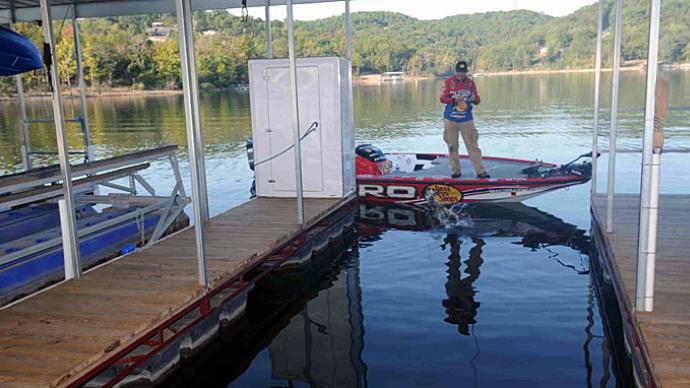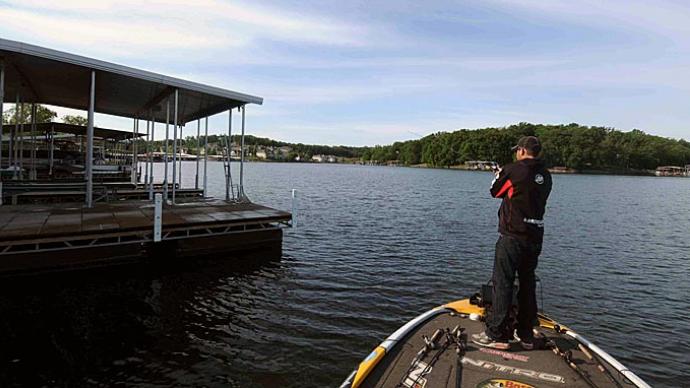There’s something about a long row of boat docks that makes bass anglers smile. There are several reasons.
First is the bass-holding potential of boat docks. Offering shade, cover, and food, these shoreline structures attract bass year-round, including big ones, whether they stand in a river, lake, or reservoir. But they are particularly sweet in summer because of increased activity in warm shallow water.
Second is the almost countless number of targets that can be fished—posts, floats, lifts, moored boats, and more, each warrant a cast or two. And displaying the skills needed to quietly drop your lure next to one — without getting hung up — is its reward, one that’s even better when a bass bites your bait. Pulling that off consistently is easier when you fish specific lures.
The best dock-fishing lures share a few characteristics. They need to avoid snags. You’ll be casting them to tight spots that can be surrounded by ropes, aquatic vegetation, and other obstacles. Exposed hooks will snag. Those incidents slow you down and ruin spots as you go to free your lure.
These lures are compact and can skip across the surface like a stone. Many of the best bass-holding spots around boat docks are under some overhanging cover, such as a platform, pontoon boat, or walkway. These can only be accessed with low trajectory casts, and skipping adds to their distance.
Only a handful of lure types meet all the requirements for dock fishing. And even in that subset, some do better to catch the bass that swim there. Here are five of the best, covering from the surface to the bottom.
-
Frogs and toads
Image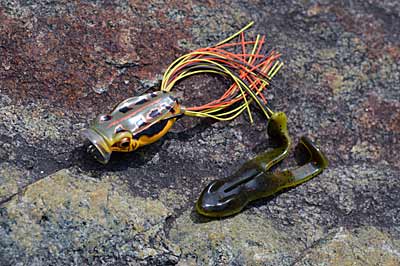
Topwater frogs and toads are weedless and easy to skip, allowing you to reach the darkest corners under docks, where the biggest bass are most likely to hide. Photo by Pete M. Anderson Not long ago, hollow-bodied frogs and soft-plastic toads only got wet when anglers wanted to fish matted aquatic vegetation or an expansive field of lily pads. But thanks to a better understanding of their effectiveness in open water, courtesy of Dean Rojas’ top finish at the 2004 Bassmaster Classic on Lake Wylie, they’ve taken on a bigger role.
Frogs and toads imitate their namesakes. But fish them around laydowns, rip-rap, or docks in early summer, and they imitate spawning shad flicking their way across the surface. And through summer, they can imitate bluegill, which spawn on every full moon. While these lures resemble an easy meal for bass, their true worth is in their ability to reach the deepest, darkest corners of docks.
Their hooks are hidden, so they won’t grab ropes or other obstacles when fished around docks. And their smooth bellies mean that they can be skipped undercover. And while submerged or matted vegetation growing around a dock make it tough to fish other lures, these slide right over it.
Skipping these and other lures requires three things. First, you must be patient and practice the underhand roll cast that puts your lure at the perfect angle to the water. You’ll need a casting reel whose brakes are released just enough that only your lure’s weight is needed to pull line from its spool slowly. And you’ll need a medium-action rod, which flexes through the top third of the blank, easily generating enough lure speed to ensure far-reaching skips.
While braided line is standard equipment when fishing frogs and toads across thick aquatic vegetation, switch to monofilament — 15- to 20-pound test — when fishing them around docks. Its stiffness will keep it from catching, wrapping, and wedging into crevices. And unlike fluorocarbon line, it floats, keeping your topwater lure on the surface.
-
Spinnerbaits
Image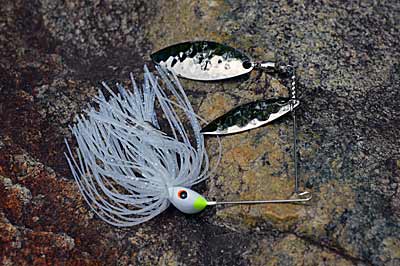
When dock bass are biting, you need to keep moving. Spinnerbaits let you cover water and different depths quickly. Photo by Pete M. Anderson Hiding in the shadow of the vibrating jig is the time-tested spinnerbait. While it might not enjoy the limelight that it did a couple of decades ago, it still is a versatile bass catcher. And it deserves to be front and center in your dock-fishing arsenal.
Vibrating jigs like Chatterbaits catch their fair share of dock bass. But spinnerbaits, especially those rigged with willow-leaf blades, can be retrieved faster in clear water, pulling strikes when run parallel with docks, covering plenty of water in the process. They are also easier to fish, allowing you to slow roll them along the base of deep dock posts, where brush piles are often sunk in Southern reservoirs. You may not see this productive cover, but your spinnerbait will find it while its frame and blades keep your hook from hanging up.
Vary your casting angles. While straight down the sides of a dock will get bites, bass under plenty of fishing pressure need something different to bite. Try coming across the corners at a 45-degree angle, or bring your spinnerbait from deep to shallow water. Keep experimenting until you get a few bites, then stick with it.
Regardless of which direction you fish your spinnerbait, make sure bass can access it. This is particularly important when fishing floating docks. Tow it too shallow, and the dock hides it. So, keep your spinnerbait deeper than the float, so bass underneath it can see and strike it. Keeping it there can be done in three ways: switch to a slightly heavier spinnerbait, switch to smaller blades, or slow your retrieve.
Your casts need to be short and accurate. While you can pitch these lures to spots on a dock, an underarm roll cast will get you a bit more distance. So, switch to a rod slightly shorter than today’s norm. A 6-foot casting rod, for example, is easier to cast underhand and has enough leverage to wrestle big bass from underneath docks.
-
Stick worms
Image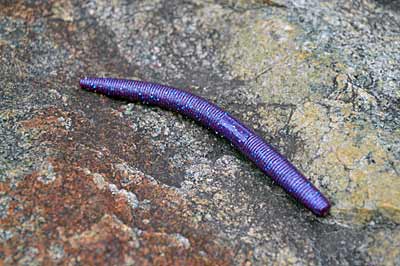
Whether rigged Texas-style or wacky, dock bass can’t resist a stick worm, it fishes a variety of depths and amounts of cover. Photo by Pete M. Anderson It’s almost impossible to find a bass angler who doesn’t have a stick worm in their boat. Led by Yamamoto’s Senko, these soft-plastic lures catch bass year-round, especially from shallow water. They mimic the prey dock bass eat and are easy to skip into the tightest spots.
Stick worms can be rigged wacky — hooked once through the middle — or Texas-style. Both skip well, so let the amount of cover dictate which one you use. Wacky-rigged ones have slightly more action, a slower fall, and are more attractive to pressured bass. But with an exposed hook, they’re best around docks without aquatic vegetation. So, switch to a Texas rig when you fish ones with vegetation.
Fish stick worms slowly. They have inherent action, so you don’t have to move them much. Pitch them to each target and let them settle to the bottom, resting for as long as you can stand. Bites can be subtle, so use braided line, which is extremely sensitive.
-
Tubes
Image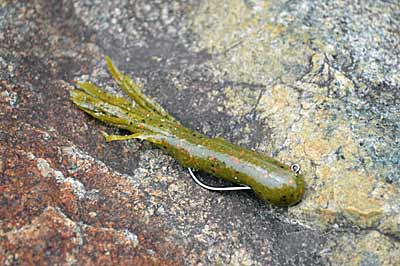
Tube jigs pack a big punch in a small package. They skip well into tight places and generate bites from pressured bass. Photo by Pete M. Anderson Some days bass only bite finesse baits. And while small worms, jigs, and even crankbaits can fill that role, tube jigs do it best when fishing docks. That’s not to say they won’t work when the bite is on. They will, and they do.
Tube jigs mimic the baitfish and crawfish that hide around docks. They skip exceptionally well, allowing you to put them far under docks or moored boats. Several retrieves work. They can be made to swim with constant rhythmic twitches of your rod tip. They can be hopped along the bottom. And they can be dragged along the bottom, creating a wandering path that mimics a scooting crawfish, kicking up silt that attracts bass.
Take care in how you rig your tube jig. They can be Texas rigged, though that approach kills much of their random movement, which is key to generating bites. So, the traditional rigging — jig head inserted into the tube — is the best way. But be careful with its exposed hook around mooring lines, boat covers and seats, and other sticky situations. A better way may be the Stupid Rig, whose specially designed jig head goes into the tube, and its unique hook allows weedless rigging, protecting the hook point.
-
Jigs
Image
Jigs regularly catch the biggest bass from docks. Choose one heavy enough to pitch accurately, adding a bulky trailer if the bass want a slower fall. Photo by Pete M. Anderson If you’re looking for an all-around lure for fishing docks, then look no further than the jig. Shallow or deep, sparse or thick cover, skipped or pitched, you’ll be hard pressed to find a lure that catches more or bigger bass from docks than this one.
The best jigs for fishing docks have a hook with a large gap and fiber weed guard. The hook offers plenty of room for a trailer and a bass. And these weed guards can be thinned — not shortened — making them slightly softer, ensuring easier hook sets while maintaining a functional level of snag protection.
Jig weight is an important consideration, too. Skipping and pitching accuracy increases with the weight of your lure. It’s easier to put a 1/2-ounce jig on a specific spot, for example, than it is a 1/4-ounce model. While a heavy jig sinks fast, which can generate reaction strikes from bass in clear water, they can be slowed for cold or shallow water. If you’re tying your own jigs, skirts made with more or thicker strands of material will put on the brakes. Adding a bulky soft-plastic trailer has the same effect.
BassResource may receive a portion of revenues if you make a purchase using a link above.



